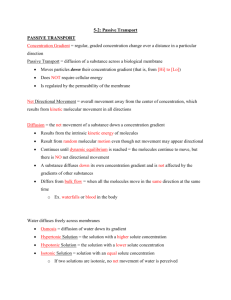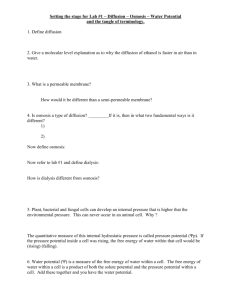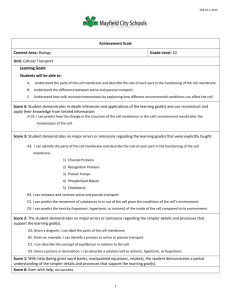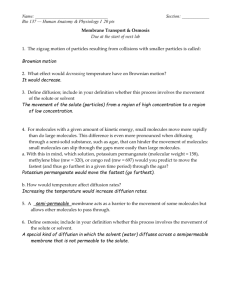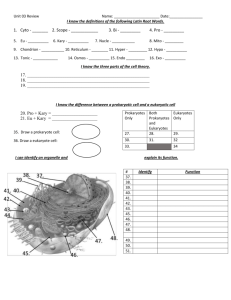Practice Test 2 Answers
advertisement
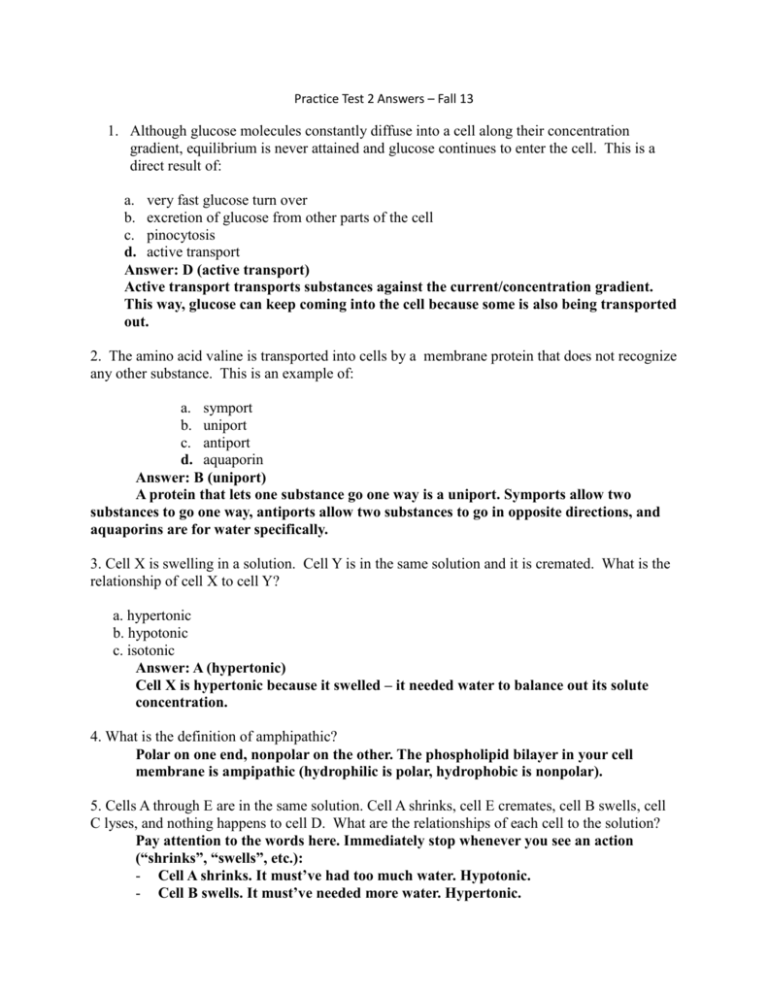
Practice Test 2 Answers – Fall 13 1. Although glucose molecules constantly diffuse into a cell along their concentration gradient, equilibrium is never attained and glucose continues to enter the cell. This is a direct result of: a. very fast glucose turn over b. excretion of glucose from other parts of the cell c. pinocytosis d. active transport Answer: D (active transport) Active transport transports substances against the current/concentration gradient. This way, glucose can keep coming into the cell because some is also being transported out. 2. The amino acid valine is transported into cells by a membrane protein that does not recognize any other substance. This is an example of: a. symport b. uniport c. antiport d. aquaporin Answer: B (uniport) A protein that lets one substance go one way is a uniport. Symports allow two substances to go one way, antiports allow two substances to go in opposite directions, and aquaporins are for water specifically. 3. Cell X is swelling in a solution. Cell Y is in the same solution and it is cremated. What is the relationship of cell X to cell Y? a. hypertonic b. hypotonic c. isotonic Answer: A (hypertonic) Cell X is hypertonic because it swelled – it needed water to balance out its solute concentration. 4. What is the definition of amphipathic? Polar on one end, nonpolar on the other. The phospholipid bilayer in your cell membrane is ampipathic (hydrophilic is polar, hydrophobic is nonpolar). 5. Cells A through E are in the same solution. Cell A shrinks, cell E cremates, cell B swells, cell C lyses, and nothing happens to cell D. What are the relationships of each cell to the solution? Pay attention to the words here. Immediately stop whenever you see an action (“shrinks”, “swells”, etc.): - Cell A shrinks. It must’ve had too much water. Hypotonic. - Cell B swells. It must’ve needed more water. Hypertonic. - Cell C lyses (swells/explodes). It must’ve needed more water and accidentally burst when it got too much of it. Hypertonic. Cell D does nothing. Isotonic. Cell E cremates (shrinks). It must’ve had too much water. Hypotonic. 6. What is Tay-Sacs disease and what organelle(s) is/are involved? Tay-Sachs deals with lysosomes. They do not have/have a deficient amount of the enzyme Hex-A which causes them to not digest the things they should (usually bad bacteria or fatty acids). 7. When a cell is deprived of oxygen, its lysosomes tend to burst and release their contents into the cell. As a result of this that cell will: a. recycle damaged organelles b. produce additional ER c. undergo cell division d. produce replacement lysosomes e. undergo autolysis Answer: E (undergo autolysis [burst]) When a lysosome bursts, its dangerous, corrosive enzymes are released into the cell and freely roam. When this happens, the cell will take one for the team and kill itself to make sure those enzymes don’t get spread through cell division. 8. You take a flower that is wilted and place it in water. The flower revives and is no longer wilted. Is the flower hypertonic, hypotonic or isotonic to the water in which you placed it? The flower was originally hypertonic. It needed water, and was wilting because it had too much solute. 10. A cell that contains 0.9% solute is placed in a petri dish that contains 0.9% solvent. Is the cell isotonic, hypotonic or hypertonic to the solution in the petri dish? The cell is hypertonic; it has less water/solvent. 11. Name all the cellular organelles and their functions! The nucelus contains DNA and the nucleolus. The nucleolus produces ribosomes (these can be free or bound to the RER). The rough ER and ribosomes synthesize protein. The golgi attaches directions/a zip code to proteins. Microtubules move proteins across the cell. Peroxisomes and smooth ER detoxify. Lysosomes degrade (lack of enzyme Hex-A causes Tay-Sachs disease). 12. Your blood is normally about 0.9% NaCl. Is Gatorade or any other power drink, isotonic hypertonic or hypotonic to your blood? So, 0.9% solute, 99.1% water. Any drink would be very hypertonic in comparison to this whopping 99.1% concentration of water. 13. In Osmosis, water always moves toward the solution with the ___ solute concentration. a. Higher b. Lower Answer: A (Higher) Key word here is solute, not solvent. In osmosis, water moves toward the solution with the lower water concentration and thus higher solute concentration. 14. If a RBC swells, the solution in which you placed it is hypertonic. a) True b) False Anytime you see the word “swells”, whatever it is (usually a cell) is hypertonic – it needed water to rush in to even its solute concentration out. The solution here is not hypertonic – it is what lost water to the cell. 15. Name and define each of the types of transport discussed in lecture. Passive transport (no energy required), active transport (energy required, moves against the current/concentration gradient). Osmosis is the passive transport of water. Diffusion is passive. Facilitated diffusion is when a protein helps. 16.The abnormal amino acid in sickle cell hemoglobin is: a. valine b. gultamic acid c. cystine d. none of the answers is correct e. more than one of the answers is correct Answer: A (valine) 17.Which of the following pertains to protein: a. CHON b. CH c. CHO d. CHONP e. None of these Answer: A (CHON) Proteins have an amino group (hence the N) but don't require a phosphate (hence no P). Another way to think of this is that proteins are made up of amino acids, which are themselves made up of an amino and a carboxyl group. What elements do amino acids thus have? N and H in amino, and C, O, and H in carboxyl, so CHON. Proteins are made up of amino acids, so they are also CHON. 18.There are 20 different amino acids in the proteins that make up living cells. The primary difference in the amino acids is in their: a.R groups b.number of R groups c.phosphate groups d.sequence of R groups e.more than one of the choices is correct Answer: A (R groups) The R group is the only thing that differentiates one amino acid from another. 19. Analysis of compound Y indicates that it contains phosphate groups and the base uracil. Based on this information which of the following information is the best description of this substance? a.RNA b.DNA c.An inorganic compound d.Polypeptide e.Enzymes Answer: A (RNA) Whenever you see “uracil”, you know it’s talking about RNA and not DNA. 20. List each structural level of protein and explain what holds each level together. Primary – the order of amino acids Secondary – hydrogen bonds form Tertiary – R groups attract Quaternary – polypeptide chains form a protein (aka multiple tertiary structures come together to make quaternary)

